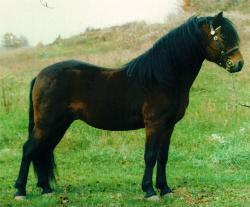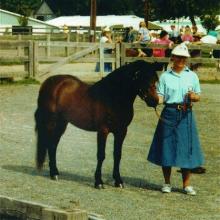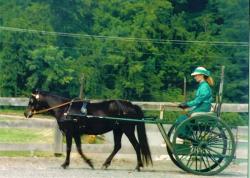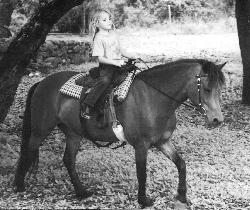 Brandsby Jack Frost |
The Dartmoor Pony |
The Dartmoor Pony is an attractive pony very much in demand for its gentle nature as a child's first riding mount. Dartmoor ponies have provided children and families with wonderful experiences due to their versatility and adaptability to riders of all ages. It is not unusual for the same pony to patiently carry a toddler on lead line, be used by an older child for 4H or Pony Club and then happily work in harness taking the parents for a Sunday drive. Below are some of the top reasons Dartmoors are becoming increasingly more popular:
1) The pony averages around 12 hands thus making it easy for a child to groom, saddle and mount themselves.
2) They move with a low, smooth stride making their riders feel they are on a much larger mount.
3) They are not easily excitable like their cousins, easy to train and posses a gentle & kind heart like the family Labrador.
4) In the showring, the Dartmoor has competed with outstanding success against other breeds in jumping, cross-country and dressage proving that it is a breed to be reckoned with in competition.
5) When used as a harness pony, they can hold their own against much larger equines displaying toughness & courage allied with their calmness.
| This breed originates from the southwest coast of England in the county of Devon. It received its name from a wild area of moorland called Dartmoor, which stands over 1000 feet above sea level. Dartmoor's weather can be quite intense. It receives full force gales from the Atlantic Ocean and the terrain is very rocky with sparse vegetation. In response to this environment, the pony became sure-footed, hardy and full of stamina enabling it to survive in almost any climate or condition in the world. |  Thistledown Farm mare & foal |
Globally, there are very few Dartmoor ponies as compared to their cousins. Breeding societies worldwide are working hard at retaining quality and increasing their numbers so they may provide reliable and sensible ponies to fill the increase in demand. Typically, once a Dartmoor Pony makes it into a family, they are rarely sold. When the children outgrow them as riding mounts, they go on as harness ponies or are passed on to relatives to teach their young ones the love of riding and caring for a pony.
Dartmoors are the best possible foundation stock for breeding larger children's ponies. The Dartmoor contributes both its disposition and plenty of bone for a small warmblood type of pony who possesses versatility, strength, and most importantly their good nature.
History:
 Farnley Beau Brummel |
Dartmoor is about 365 square miles of almost solid granite highlands. A thin layer of soil covers protruding rocks throughout with little fields, grassy slopes and wooded valleys along the edges. High Willhays is found on the northern side and is the highest point of England (2,038 feet). Typical to these highlands, soil is poor and acidic with minimal vegetation. Being able to survive such bleak conditions, The Dartmoor Pony became known as a race of pony that was surefooted and hardy. In the 1820's, the Dartmoor Pony became very popular in the nearby towns for it's ability to cross the rough and mountainous roads. |
Ponies on Dartmoor are believed to have been in existence for quite some time. They have survived unbelievable hardships from both nature and man. Hoof prints, assumed to be from domestic animals (possibly the Dartmoor pony), were discovered on Shaugh Moor within the boundaries of a Bronze age settlement dating back to approximately 2000 BC. One of the earliest recorded references to Dartmoor ponies is in the will of Awifwold of Crediton, a Saxon Bishop who died in 1012. During the reign of Henry I (1100-1135), a stallion was taken from Dartmoor, then a royal forest, to be bred with the royal mares. In 1535, Dartmoor ponies, as well as other ponies of the British Isles, almost became extinct.
Henry VIII passed legislation to eliminate "nags of small stature." Due to the weight of the armour worn by soldiers, it was necessary to breed a horse of considerable stature to carry both soldier and armour. Fines were imposed on anyone using a stallion under 14 hands. Six years later, another law was passed by Henry the VIII (1541), prohibiting the use of "any stoned horse under 15 hands" and all "unprofitable beasts" (smaller ponies were caught and destroyed). Queen Elizabeth later annulled these laws. Luckily, during the reign of Edward VII, the king valued the Dartmoors for his polo teams and there was a huge comeback of the Dartmoor Pony until the World Wars.
During World War I and II, Dartmoors and other ponies once again declined in numbers. Since that time, the Dartmoor had steadily made a comeback due to strict breeding practices and demand.
 Wilby Viceroy |
Throughout history, the Dartmoor pony has been used for a variety of services. They have been used as pack animals carrying tin from the mines, wool, granite and other materials. They also pulled carts to and from market and at the start of the 20th century until the 1960s, Dartmoor Prison officials raised unregistered ponies for escorting inmates to and from their duties outside the prison. |
In was not until 1898, that the Polo and
Riding Pony Society (later known as the National Pony Society) set up local
committees to provide descriptions of each native breed of pony giving each a
section of the studbook for registration. With exception to the height, the
original description of the Dartmoor is almost identical to today's standard.
The height limit for a stallion was 14 hands and for a mare 13.2 hands but very
few ponies came close to that height. More Dartmoors were first registered than
any other breed.
The 1920s were an important time for the Darties. From 1924 to 1927, the
Dartmoor Pony Society came into existence. The height limit was set to 12.2
hands. They knew that the Dartmoor's potential did not start and end with polo.
There were many outlets the Dartmoor breed could perform for both profit and
enjoyment. Some of the most influential bloodlines of today were first noticed
in the twenties. The D. P. S. continued with membership, breeding, inspections
and showing but did not take over the registration process until 1977.
| The 1930s were a period of consolidation. In the 1940s, very few Dartmoors were registered (partially due to World War II.) Registration by inspection was introduced, and prizewinners at selected shows became eligible for registration. By the end of the 1950s, the breed was in much better shape. Registration by inspection finished in 1957. All future registrations in the studbook were of ponies whose parents were already registered |  Coopermill Tosca |
. Preservation of Ponies on Dartmoor:
Over the years, the quality and number of pure Dartmoor ponies on the moorland
declined. Since the moor is "common land" there were no restrictions
as to what could be turned out. Some farms on Dartmoor are given grazing rights
on "the commons" for a specific number of cattle, sheep and ponies. A
pony on Dartmoor is not necessarily a Dartmoor pony. Breeds such as the
Shetland, Arabian and Thoroughbred have been turned out on the moor at various
times. Dartmoor also reflected the times. In the 1940s, there was a demand for
small pit ponies. In the 1950s, pinto ponies were popular. With each trend, it
was evident on the toll it placed on the quality of the pure Dartmoor. It was
only 100 years ago that the Dartmoor ponies had a section in the National Pony
Society's handbook and while the breed was being kept pure by stud farms, the
ponies on Dartmoor began to decline by the crossbreeding with less hardy
breeds. A plan had to be formed to preserve the breed.
In 1951, Dartmoor was designated a national park, The pony was chosen to be on
its logo. In 1987, the Duchy of Cornwall joined Dartmoor Pony Society along
with the National Park Authority and the Ministry of Agriculture to improve the
quality of the moor ponies. They developed the Dartmoor Pony Support Scheme.
Approved typey mares are allowed to run with a pedigreed stallion in one of
several Newtake's (an enclosed part of the moor). It is hoped that this will
encourage the local farmers to breeding the true to type Dartmoor who is able
to survive the harsh environment.
The Dartmoor Pony Society opened a
supplementary register to include the inspected mares as foundation stock.
There has been a noticeable improvement of the foals over the years. It is
hoped that the majority of the fillies born who are upgraded after inspection
will return to the Scheme and eventually replace the original mares. This will
give breeders a new genetic pool, which is important to future breeding. It
also provides visitors to the park a chance at seeing the Dartmoor Pony in its
native habitat.
Beneficial Crosses in the Breed
As early as the twelfth century, blood from other equine breeds has been
introduced. The present day Dartmoor Pony has been beneficially crossbred
creating an elegant, talented, kind-hearted riding and driving pony who also
make exceptional jumpers. This pattern of improvement has seen this pony become
one of the most successful of all British Isle pony breeds. While the breed has
benefitted from some crosses, we must also remember that the Dartmoor has been
and is still being used to help or create other breeds worldwide being valued
for their unique qualities.
The Pony Market
In the 1950's, pony classes became very popular. The Future of the Dartmoor
brightened. Virtually all registered Dartmoors are now on private property.
Stud farms throughout Great Britain have been breeding and showing their
registered ponies constantly striving to keep the breed true to its origins and
providing the rest of us a chance to own a first class pony.
 Coopermill Aida |
Ponies are now being raised throughout Europe, the United States, Australia and smaller countries. By the careful selection and breeding through the stud farms and the preservation efforts of the farmers' ponies on the moor, the number of Dartmoors have a chance of raising to that of other popular pony breeds. |
The Standard of the Dartmoor Pony
Height: Not exceeding 12.2 hands (127cm) (50")
Color: Bay, black, brown, chestnut, gray, and roan. Piebald and skewbald
are not allowed. Excessive white markings are discouraged. (Colors in Italics
are the more dominant colors)
Head and Neck: The head should be small with large kindly eyes and small
alert ears. It should be well set on a good neck of medium length. The throat
and jaws should be fine and showing no signs of coarseness or throatiness.
Stallions have a moderate crest.
Shoulders: Good shoulders are most important. They should be well laid
back and sloping but not too fine at the withers.
Body: Of medium length and strong, well-ribbed up and with a good depth
of girth giving plenty of heart room.
Loin and Hindquarters: Strong and well covered with muscle. The
hindquarters should be of medium length and neither level nor steeply sloping.
The tail should be well set up.
Limbs: The hocks should be well let down with plenty of length from hip
to hock, clean cut and with plenty of bone below the hock. They should have a
strong second thigh. They should not be 'sickled' or 'cow-hocked'.
The fore legs should not be tied in at the elbows. The forearm should be
muscular and relatively long and the knee fairly large and flat on the front.
The cannons should be short with ample good, flat, flinty bone. The pasterns
should be sloping but not too long. The feet should be hard and well shaped.
Movement: Low and straight coming from the shoulder with good hock
action but without exaggeration.
General: the mane and tail should be full and natural. The Dartmoor is a
very good-looking riding pony, sturdily built yet with quality.
 |
courtesy of: The American Dartmoor Pony Association, www.users.hockinghills.net/~dartmoor/ 203 Kendall Oaks Dr., Boerne, TX 78006, ADPAsec@aol.com, (830) 249-8103, Fax: (830) 249-7322 For a brochure, sales list or info about membership, send a self addressed stamped envelope to above address. |
Millers has a Dartmoor Video available for around $10 if you would like to see them in action in Great Britain.
As for membership, the cost is $20 or $25 for the family. We have newsletters, year books called diaries, and stud books available. Send dues to:
The American Dartmoor Pony Association at the above address